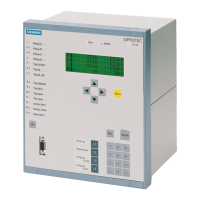2.5 Distance Protection
157
7SD5 Manual
C53000-G1176-C169-1
Figure 2-54 Release logic of a zone (example for Z1)
*) forward and reverse affect only the measured values, not the logic
In total, the following zones are available:
Independent zones:
• 1st zone (fast tripping zone) Z1 with ZR(Z1); may be delayed by T1-1phase and
T1-multi-phase,
• 2nd zone (backup zone) Z2 with ZR(Z2); may be delayed by T2-1phase and T2-
multi-phase,
• 3rd zone (backup zone) Z3 with ZR(Z3); may be delayed by T3 DELAY,
• 4th zone (backup zone) Z4 with ZR(Z4); may be delayed by T4 DELAY,
• 5th zone (backup zone) Z5 with ZR(Z5); may be delayed by T5 DELAY.
Dependent (controlled) zone:
• Overreaching zone Z1B with ZR(Z1B); may be delayed by T1B-1phase and / or
T1B-multi-phase.
2.5.3.2 Setting Notes
General The function parameters for the MHO characteristic only apply if during the configura-
tion of the scope of functions the MHO characteristic was selected for phase-phase
measurement (address 115) and/or phase-earth measurement (address 116).
Grading
Coordination Chart
It is recommended to initially create a grading coordination chart for the entire galvan-
ically interconnected system. This diagram should reflect the line lengths with their
primary impedances Z in Ω/km. For the reach of the distance zones, the impedances
Z are the deciding quantities.
The first zone Z1 is usually set to cover 85 % of the protected line without any trip time
delay (i.e. T1 = 0.00 s). The protection clears faults in this range without additional
time delay, i.e. the tripping time is the relay basic operating time.
The tripping time of the higher zones is sequentially increased by one time grading in-
terval. The grading margin must take into account the circuit breaker operating time
including the spread of this time, the resetting time of the protection equipment as well
as the spread of the protection delay timers. Typical values are 0.2 s to 0.4 s. The
reach is selected to cover up to approximately 80 % of the zone with the same set time
delay on the shortest neighbouring feeder.
When using a personal computer and DIGSI
®
to apply the settings, these can be op-
tionally entered as primary or secondary values.
www . ElectricalPartManuals . com
